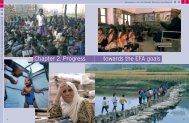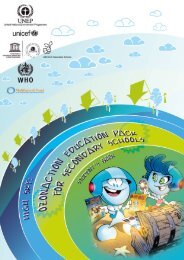Financing Education / pdf - Unesco
Financing Education / pdf - Unesco
Financing Education / pdf - Unesco
Create successful ePaper yourself
Turn your PDF publications into a flip-book with our unique Google optimized e-Paper software.
0<br />
0<br />
8<br />
CHAPTER 4<br />
2<br />
<strong>Education</strong> for All Global Monitoring Report<br />
Figure 4.13: Breakdown of aid commitments to education by level,<br />
2004 and 2005 average<br />
France<br />
IDA<br />
Japan<br />
Germany<br />
United States<br />
EC<br />
United Kingdom<br />
Netherlands<br />
AsDF<br />
Canada<br />
Norway<br />
Spain<br />
Basic<br />
Belgium<br />
Australia<br />
Secondary<br />
Denmark<br />
Sweden<br />
Post-secondary<br />
AfDF<br />
Austria<br />
Unspecified<br />
UNICEF<br />
Finland<br />
Portugal<br />
Ireland<br />
New Zealand<br />
FTI<br />
Italy<br />
IDB Spec. Fund<br />
Greece<br />
Switzerland<br />
Luxembourg<br />
0.0 0.5 1.0 1.5<br />
Constant 2005 US$ billions<br />
Notes: Only direct aid to education is broken down by level.<br />
AfDF = African Development Fund; AsDF = Asian Development Fund; EC = European Commission; FTI = Fast Track<br />
Initiative Catalytic Fund; IDA = International Development Association; IDB = Inter-American Development Bank<br />
(Special Fund).<br />
Source: OECD-DAC (2007c).<br />
13. The increase may be<br />
overstated to the extent<br />
that the definition of<br />
poverty-reducing<br />
expenditure can become<br />
more comprehensive<br />
within a country over time.<br />
It may also vary from one<br />
country to another.<br />
of finance for education in Latin America and the<br />
Caribbean (Box 4.3). The second additional source<br />
is countries outside the twenty-two OECD-DAC<br />
members, and private foundations. Sixteen non-<br />
DAC countries report aid activities to the DAC<br />
Secretariat. Of these, only the Czech Republic,<br />
the Republic of Korea and Turkey report aid for<br />
education. Most goes for scholarships in tertiary<br />
education, with very little for basic education.<br />
Other sources of aid for education are the Islamic<br />
Development Bank and the Gulf Cooperation<br />
Council. At a meeting of bilateral and multilateral<br />
donors in November 2006, these two institutions<br />
pledged US$109 million for education in Yemen,<br />
out of a total of US$307 million pledged<br />
(Government of Yemen, 2007). China has recently<br />
emerged as a potential source of external finance<br />
for African countries. However, the focus of the<br />
US$5 billion China-Africa Development Fund is<br />
on natural resources, infrastructure, large-scale<br />
agriculture, manufacturing and industrial parks.<br />
Few, if any, of the funds are likely to be directed<br />
to basic education.<br />
In addition to governments, some private<br />
foundations are becoming active in basic education<br />
in developing countries. In May 2007, the Soros<br />
Foundation pledged US$5 million for Liberia if a<br />
matching pledge could be found, and the Gates<br />
and Hewlett Foundations have committed<br />
US$60 million over three years for programmes<br />
aimed at improving learning achievements in lowincome<br />
countries. The largest initiative reported so<br />
far is the US$10 billion endowment of a foundation<br />
to raise educational standards and literacy in the<br />
Middle East, announced by the ruler of Dubai at<br />
the World Economic Forum in Jordan in June 2007<br />
(The Guardian, 2007).<br />
Debt relief moves up the list of priorities<br />
The Dakar Framework for Action argued that<br />
higher priority should be given to debt relief linked<br />
to expenditure on poverty reduction programmes<br />
having a strong commitment to basic education.<br />
While the recent debt relief programmes have<br />
benefited only a subset of the world’s low-income<br />
countries, for those that have benefited the<br />
programmes have been among the most effective<br />
international initiatives to increase government<br />
resources.<br />
The introduction of the Enhanced HIPC Initiative<br />
for debt relief in 1999, which expanded the previous<br />
programme begun in 1996, required countries<br />
to prepare and implement a poverty reduction<br />
strategy as a condition for qualification. Thirty<br />
countries have since qualified for relief – twentyfive<br />
in sub-Saharan Africa, four in Central America<br />
and the Caribbean, and one in South America –<br />
and a further ten are eligible. All are least<br />
developed countries. On average, the ratio of debt<br />
service to GDP in these countries fell from 3.6%<br />
to 2.2% between 1999 and 2005, and the ratio<br />
of debt service to government revenue fell from<br />
23.5% to 11.7%, allowing governments to increase<br />
expenditure on domestic programmes (IDA/IMF,<br />
2006). Part of the HIPC process is monitoring<br />
spending on poverty-reducing measures. Across<br />
the thirty countries, expenditure on such activities,<br />
in which education is always central, increased on<br />
average between 1999 and 2005 from 6.4% to 8.5%<br />
of GDP and from 40.9% to 46.1% of total<br />
government expenditure. 13 The absolute increase<br />
in poverty-reducing expenditure was far larger<br />
than the decline in debt service payments. This<br />
suggests that governments have used not only<br />
funds freed by debt relief for their poverty<br />
reduction programmes, but also other resources.<br />
162

















